Small roses: varieties and rules of care
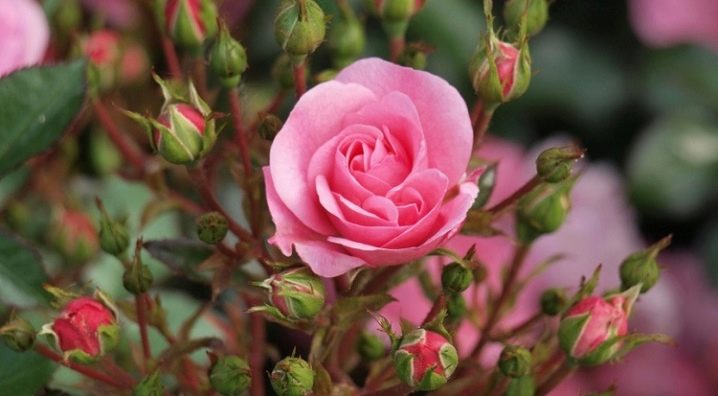
The presence of flowers in the room and outside is always appropriate and pleasant, especially if it is roses. Often, the dimensions of a room or garden are insufficient to grow full-fledged bushes, therefore small varieties of these flowers were bred. The abundance of varieties makes you think about the choice, therefore it is necessary to understand the difference between each of them. In order to properly plant and grow such roses, it is important to know how it is done.
Peculiarities
Small roses are not inferior to large varieties in beauty and aroma, only such characteristics will be distinctive as:
- the height of the bush, which averages 15-20 cm, although there are varieties that grow up to 50 cm;
- features of the crown, it is formed more dense, with small leaves that have a matte surface;
- the size and formation of buds - they are small, from 3 to 6 cm, and grow in inflorescences of 5-6 pieces;
- the possibility of the formation of buds with different colors on one flower.
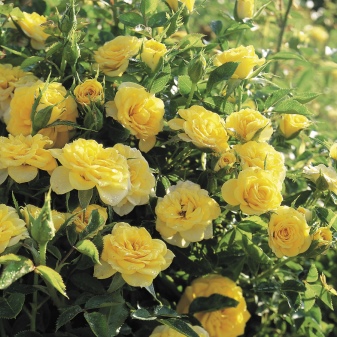
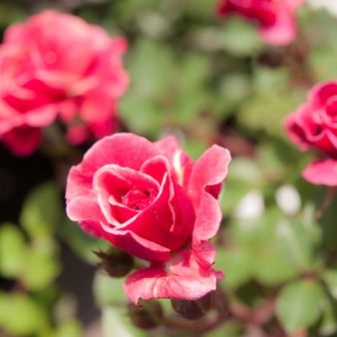
The description of a dwarf variety of roses gives an idea of exactly how the bush looks like, but this plant has a number of differences from a higher relative. Small roses bloom almost all year round, as they are easily transferred from street to room.
To make the growing procedure more convenient, there are several options for how exactly this can be done year-round:
- planting in a flower pot;
- landing in an open container located outside;
- planting roses in the garden in the warm season.
Due to the wide variety of such flowers, you need to learn as much as possible about the varieties of dwarf roses.
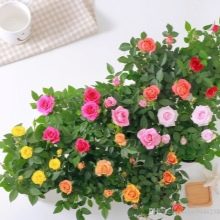
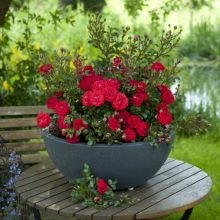
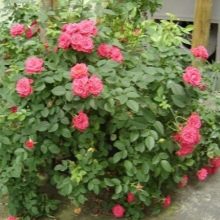
The best varieties and their characteristics
The popularity of roses has always been at its best, but it is not always convenient to grow full-fledged bushes at home, even with a flower garden. The appearance of mini-varieties of these flowers has greatly simplified the task of caring for them. Especially popular is the multi-flowered ever-flowering rose. varieties "Garden Aroma" because of its beauty and unpretentiousness. A distinctive feature is its cultivation using seeds, which eliminates the need to purchase a seedling, which costs several times more.
Caring for the "Garden Fragrance" is quite simple, the flower is not demanding, it can be left in the garden all year round, because it tolerates cold weather well. In warm weather, the bushes bloom profusely, pleasing the eye, and also exude a pleasant honey aroma.

Of the external features of the variety, it is worth noting the following:
- height from 20 to 30 cm;
- leaves of a dark green hue, dense;
- flowers have a semi-double structure and a size of about 3 cm;
- the color gamut can range from light, almost white, to deep pink.
The flowering period begins in June until the onset of cool weather in late September. It is noteworthy that this variety produces flowers in the first year after planting. The most comfortable temperature conditions for roses are hot and dry summers, therefore they do not need abundant watering. In winter, it is possible not to cover it until frost does not exceed 15-degree temperature. Another advantage of this flower is its resistance to most diseases.

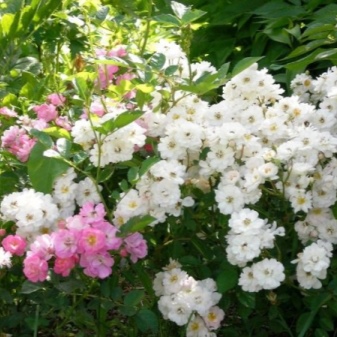
Another variety of small roses has a name "Epricot Clementine", which is associated with the color scheme of the flower.In the process of flowering, the hue changes from pink to peach, which looks beautiful and effective. The flowers are larger than Garden Aroma, they can reach 5 cm in diameter, but Epricot Clementine is practically odorless.
This variety belongs to the re-flowering, the conditions for their cultivation are slightly different. It is advisable to plant them in an open area, but so that from time to time a shadow falls on them, otherwise the bushes will quickly fade and fall off. If the rose is exposed to the sun all day, burn marks may appear on its leaves. Caring for the Epricot Clementine variety consists in loosening the soil, watering, weeding, pruning and spraying against pests. In the first year after planting, it is better to completely remove the buds so that the bush takes root better and blooms well for the next season. Roses can withstand frosts down to -7 degrees, so in warm regions they can not be covered, but in cold ones - this procedure is mandatory. The culture can be propagated only by a vegetative option, while retaining all the characteristics of the original plant.
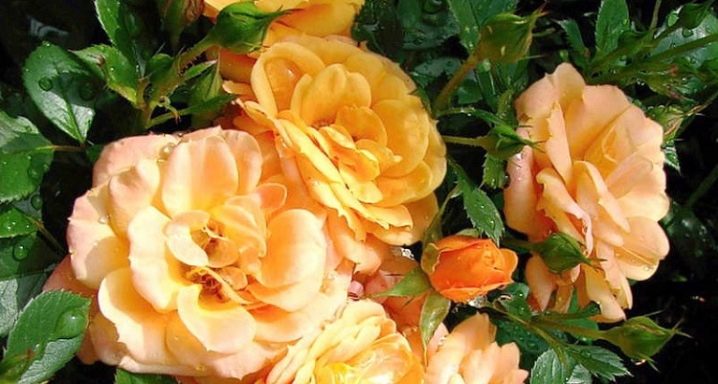
Another variety of mini roses is "Rud Morsdag", which is a small bush with bright red roses. The height of the plant does not exceed 40 cm, the inflorescences are small, but the flowers are quite large.
This variety must be planted in the sun, the soil must be prepared in advance, best suited:
- well fertilized;
- loamy;
- breathable;
- moisture-absorbing;
- slightly acidic.
"Rud Morsdag" is considered a winter-hardy variety, therefore, when the frost is mild, the bushes need not be covered. This particular variety is recognized as the most suitable for growing in pots and containers.


Another interesting variety worth considering is the name "Degenhart"... Bushes can grow up to 70 cm in height and spread over a meter in width. The flowers have a pink tint and are semi-double, their diameter is 4 cm. The variety is re-flowering, and also has an average winter hardiness. The bushes love the sun, are quite resistant to heavy rain and the most common diseases.
"Degenhart" should be covered for the winter, although nominally the bush is able to withstand up to -24 degrees. Most often, these roses are planted in containers and placed in group plantings.
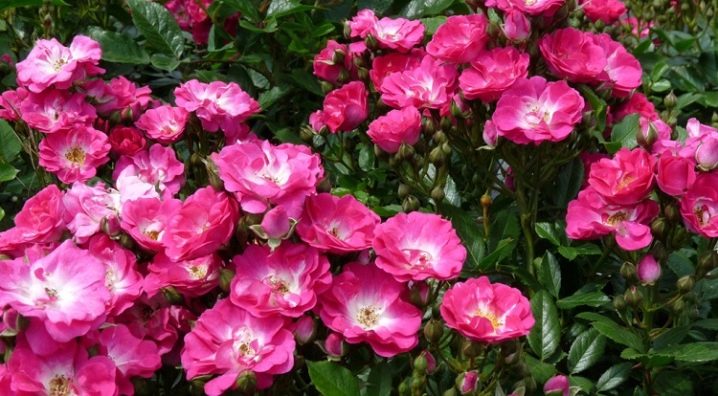
Another variety of small roses is the spray rose "Sari"which grows up to 50 cm and has yellow flowers. The plant belongs to the continuously flowering variety. The flowers are large, they can reach 8 cm, and their number in the inflorescence ranges from 8 to 10 pieces. The shape of the buds is goblet, the petals are double, the aroma is delicate, very delicate. The plant is resistant to diseases and tolerates frost well.
Separately, it should be said about the variety "Tantau Honeymilk"which also applies to small roses. The flowers are densely double, milky white with a yellowish center. A lot of them are formed on the bush, due to which the plant looks very impressive and attractive. Roses are disease resistant and hardy, surviving well in any weather conditions. Planting the variety is in the sun, while taking care of high-quality and rich soil. The optimal soil will be loamy, breathable, moisture-absorbing and slightly acidic. You can place the bushes in the garden or plant them in containers. Looks very impressive in a flower garden, where there is a mix of varieties that have different heights of the bush, flower colors and aromas.
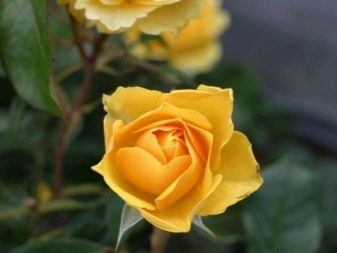
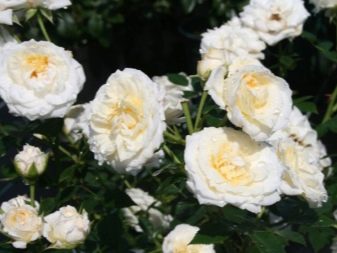
Landing rules
Miniature roses, like their larger varieties, prefer to grow in fertile, loose soil that is well ventilated and permeable to moisture. When choosing a place, you should give preference to a bright area, but with any plantings not far from the future rose garden. This is necessary in order to create a small shade for the bushes, without which they will quickly bloom and fade in the sun.
Small roses can grow both outdoors and in containers that are brought indoors for the winter. Winter-hardy varieties are usually left in the garden for the whole year, and those that do not tolerate cold well are transferred to a warmer place. There are varieties for which growing from seeds will be an advantage, and there are those for which only seedlings are needed. To choose the right type of cultivation, you need to be well versed in varietal characteristics, and make the right choice.
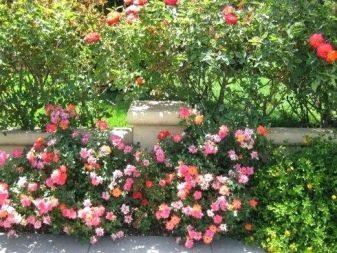
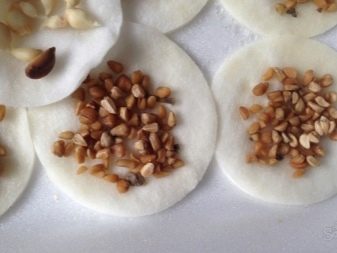
In the event that roses have been growing in the garden for a long time, they can simply be transplanted by choosing the right place. If the conditions do not correspond to the norm, then the roses will be small, they may even die. It is important to notice abnormalities in development and flowering in time and take action. To carry out the very planting of small roses, you need to follow simple instructions.
- Preparing the pit where the seedling will be planted. Its dimensions should be at least 10 cm larger than the earthen lump in which the roots are located. The bottom of the pit must be well loosened.
- In order to properly deepen the rose into the ground, it is important to plant it by grafting 4-5 cm below ground level. The soil that was dug out of the flower hole must be mixed with compost in a ratio of 1 to 3 and a handful of ash should be added.
- The seedling must be kept at the desired height, gradually filling the hole with earth. It is important to plant the bush straight.
- After planting, the soil near the rose is compacted.
- For convenient watering, it is necessary to make borders that will prevent the spread of water. It is optimal to place them at a distance of 15 cm from the bush. In spring and autumn, you need to spud roses.
If you follow these instructions, you can easily plant small rose bushes and soon enjoy their unrivaled bloom.
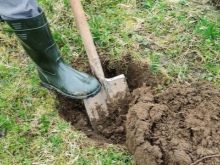

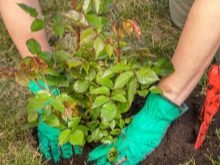
How to care?
Caring for small varieties of roses at home is simple, but each variety has its own characteristics. General rules boil down to the fact that it is necessary to give moisture to the flower, provide the soil with all the necessary nutrients and prune at the right time. A good place for planting bushes, compliance with all care measures will result in a magnificently blooming rose garden. In case of any problems with growth or flowering, you must immediately deal with the reason so as not to lose the entire flower garden.
For good growth and development of the bushes, you will need protection from pests, so do not forget about the spraying procedure. Preparing for wintering is also an integral part of caring for bushes, it can have several options. For cold climates, it is necessary to transplant small-flowered plants into a pot and remove it indoors or cover it very well.
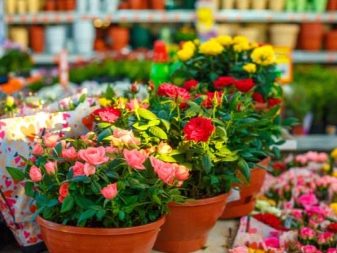
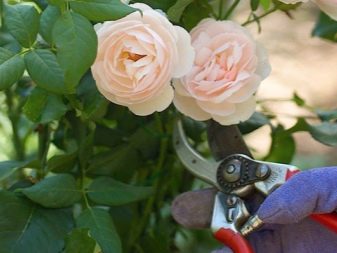
For the middle lane, it will be enough to carry out measures to protect the rose garden, which boil down to:
- breaking off flowers and peduncles;
- covering bushes with spruce branches;
- the construction of a wire frame, which will exceed the size of the bush by 10-20 centimeters;
- put this frame over the rose;
- cover the plant with insulation and a layer of film.
In addition, there are other equally important procedures such as pruning, feeding and pest control.

Top dressing
The fertilization procedure is important for creating a beautiful and lush rose garden, especially in the case of poor soil with a minimum composition of nutrients. It is important to carry out the feeding process according to the scheme:
- the first fertilizer is applied in the spring, after the shelter has been removed, it will be optimal to apply ammonium nitrate or urea;
- a month later, you must repeat the same course;
- as soon as the buds appear, it is necessary to apply complex fertilizers;
- at the end of summer, potassium nitrate or superphosphate is added to the soil.
Varietal varieties are often demanding on the soil, which means that you have to tinker with them, but the result will be worth the effort and time spent.



Watering
It is advisable to bring water under the bushes twice a day, before and after the active sun, but only in sunny and dry weather.If it is cloudy and not hot outside, one watering will be enough. In case of rain, there is no need to additionally moisten the ground, as this will lead to rotting of the plant roots. After each watering, it is necessary to loosen the soil and weed the weeds. Such abundant watering involves the introduction of a small amount of water. If it is not possible to spend so much time in the garden, you can water the roses once every few days, filling the soil well. To choose the right day for the procedure, you just need to assess the condition of the soil, if it is still wet, then it is worthwhile to wait and wait at least one more day. Young bushes consume more water than mature ones, as they need more strength and energy for the process of rooting and active growth.
The frequency and amount of watering will also vary depending on the flowering: when the buds appear, it is worth increasing the watering, during the blooming of the buds, moisture should be supplied in moderation. It is best to use settled water, which should be at room temperature, as cold plants can get sick. Watering is best done with a watering can rather than a hose.


Disease and pest control
The varietal variety of roses is huge, and they differ not only in external signs, but also in the degree of resistance to certain diseases. If you buy flowers from the market, there is a chance to learn about what the seedling can get sick, and how to treat it. In case of obtaining a rose of unknown origin, it will be more difficult to help her. To minimize the chances of being damaged by diseases and pests, you need to choose the right place for the bush and treat it with preventive solutions in a timely manner. Most often, roses are harmed:
- pink aphids;
- rose leafhoppers;
- spider mite;
- rose leaf rollers;
- rosy rotters.
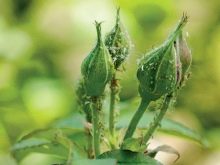


In order to treat the flower in time with the appropriate preparation, it is necessary to carefully examine the bushes at least once a week for any signs of damage. If they are detected, it is necessary to identify the pest and choose the right drug to combat it. The affected areas must be removed from the flower and burned. The most common diseases that can be seen on small roses include:
- black spot;
- powdery mildew;
- rose rust;
- downy mildew;
- gray rot.
Diseases are detected in the same way as the attacks of pests, with a careful examination of all parts of the flower. The earlier the disease was detected, the easier it is to get rid of it without losing the bush and without harming neighboring plants. Having correctly identified the cause of the problem, you can easily find the right drug that will need to process the affected bushes.
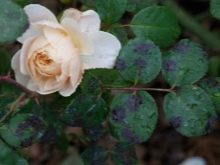


Pruning
You need to cut the bushes annually, this will make it possible to replace old stems with young ones, sick ones with healthy ones, weak ones with strong ones. It is impossible to cut the bush strongly, since the plant will need a lot of strength to restore what was lost. Spring pruning is carried out at the moment when buds begin to swell on strong and powerful branches. You need to cut off the shoot above the bud, which is directed upward, which makes it possible to prevent the bush from thickening. The cut is made oblique, directed downward from the kidney, so that the dew does not stagnate on it for a long time, and the kidney does not rot.
The pruning procedure is also useful when it is necessary to increase flowering. With the correct removal of the branches, the bush can give all its strength to the growth of flowers. Another important pruning task is preparation for wintering, for which it is necessary to remove those branches that will not be needed next year and those that interfere with the shelter of the bush. Knowing the intricacies of the procedure for pruning roses, you can get well-formed bushes with abundant flowering.
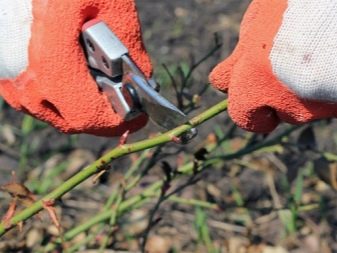

Mini roses and landscaping
Correct placement of small roses in landscape design will help you create an amazing flower arrangement and decorate any area.
- In the case of an abundance of varieties, it is worthwhile to allocate a separate area for each of them, so that you can admire each of them separately, having carefully considered and enjoying the aroma.
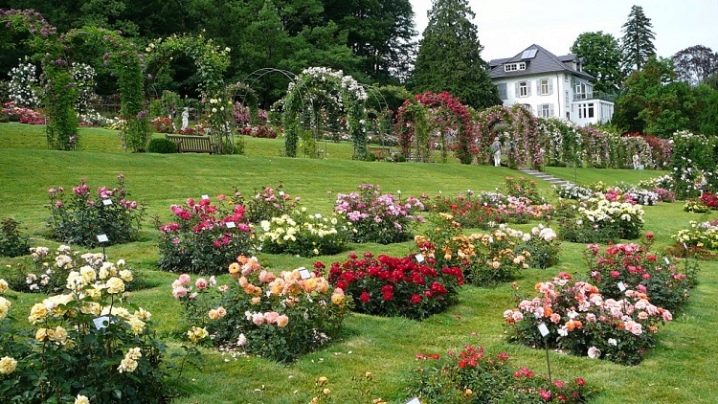
- With the help of roses, you can make mixborders, beautifully combining different varieties together. The green area, complemented by re-flowering plants, will always look good.

- The combination of tall and small roses in one composition will look original. It is important to select flowers that are contrasting in shades so that they favorably emphasize the beauty of each other.

For information on why indoor miniature roses dry, see the next video.

































































































The comment was sent successfully.